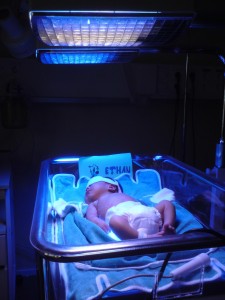Jaundice in the Newborn
BMSc (Hons) 1987, University of Dundee
MBChB 1991, University of Dundee
MRCP 1995, Royal College of Physicians
MRCPCH 1995, Royal College of Paediatrics and Child Health
CCST( Paediatrics & 2002, Royal College of Paediatrics and Neonatology) Child Health
Consultant Paediatrician and Neonatologist,Pantai Hospital Kuala Lumpur
1. What is neonatal jaundice?
This refers to is yellow discolouration of the skin of newborn babies. This It is only visible to the naked eye when the substance, bilirubin exceeds a certain level in the baby”s blood.
2. Why does jaundice occur in newborn babies?
The substance responsible for jaundice is bilirubin. This is a productproduced following the breakdown of of red blood cells breaking down although it can also come form 2 other sources. The bilirubin is, in turn, metaboliszed by the liver and is then cleared from the body in the stools and urine. When there is an increased production or reduced excretion of bilirubin from the body, the baby can then become jaundiced.
Now that we understand how jaundice is caused by bilirubin, it is then easy to understand why certain babies can get more jaundiced than others. Babies with increased bilirubin production include: babies those with elevated haemoglobin at birth, G6PD deficiency and other similar conditions. Those bBabies who cannot get rid of bilirubin rapidly include those who are premature due to immature liver, obstruction to the liver outlet and those with impaired liver function due to external and internal ‘toxins’. Dehydration will also cause more severe jaundice.
3. When do babies get jaundice?
Most babies may be jaundiced from the second to third day of life. This may increase gradually to a peak around the tenth 10th day, after which it will start to subside. The jaundice will clear and should not recur again. This is the common physiological jaundice. For breastfeed babies, the jaundice may last from four to up to 4-6 six weeks.
4. How will I know if my baby has jaundice?
Yellow discolouration is the hallmark of jaundice and. Y your baby will have a yellow tinge ofn the skin. You could also check the baby”s gums and the whites of the eyes for jaundice. In general, jaundice progresses from head to toe. If jaundice is visible only on the baby’s face, it means it is quite mild. On the other hand, if the jaundice is visible all the way down to the tummy and thighs, the bilirubin will beis very high. However, this is only a rough guide to detect the presence of jaundice and . Yyou should not rely totally on this method to decide if your baby needs treatment. For a more accurate assessment, a blood test needs to be done to measure the bilirubin level.
There are currently two2 units being used to measure forthe bilirubin level. It This is either expressed in μmol/L or mg/L. You can aAsk your child’s paediatrician which unit is used as the number may sound alarmingly different if different unit is usedto avoid confusion and unnecessary alarm. The other method of measuring the level of jaundice, i.e., by level using a skin sensor, is not accurate in Asian babies due to our varying skin pigmentation.
5.Is there any treatment for jaundice?
Yes, there is. In most babies, the jaundice can be treated with phototherapy, by administering a whitea white or blue light at a wavelength of 450 nm. You will be surprised that this simple method of treatment was not discovered until the late 1960s and was notnor widely used till the 1970s. The light changes the fat soluble bilirubin to a water soluble form, which can then be excreted in the stools and urine. For this treatment, the baby lies naked (apart from the nappy) under the lights. An eye mask is put onused to protect the eyes. You may find a variety of lights being used: such as overhead lights or a biliblanket will be used. Regular blood tests to measure the level of bilirubin will be done to prevent over- exposure.
6. What are the side effects of Phototherapy?
Like all other treatments, there may be some possible side effects. These include overheating, dehydration, rashes and mild diarrhoea.
7. Is there Aany other method besides Phototherapy?
For severe jaundice, where the phototherapy is insufficient ineffective in to reduceing the bilirubin level, a more drastic method is used. This involves using a cross matched donor’s blood and which is then exchanged with the baby’s blood. This procedure is done in the intensive care unit as continuous monitoring is essential.
8. Is there a way to prevent my baby from getting jaundice?
Prevention is better than cure. To prevent severe jaundice, follow the simple steps listed below could be done:
• Ensured your baby feeds regularly
• If you are breast feeding, make sure the baby passes urineates four to five4-5 times and passes motion two to three2-3 times a day. If not, this means you may have insufficient breast milk and will need other fluids to hydrate your baby.
• Watch your diet. Avoid foods that affect the liver function like alcohol
.
9. I have heard that traditional treatments work. Is this true?
Now that you know the basis of how bilirubin is formed and how it is excreted from the body, the answer to this is definitely no.NO!! Traditional methods include bathing in Chinese herbs or Guinness Sstout or feeding your child goat’s milk or Chinese herbs. Please refrain from trying these methods as you may be causing morecause harm to your baby.
10. Can jaundice harm my baby?
In most cases when the bilirubin does not reach a critical level, there is no harm at all. In fact, the substance bilirubin is an antioxidant and can protect cells from premature death. However if the bilirubin level increases tremendously, then the baby may suffer from complications.
There is a small chance that ofthe permanent hearing loss if the jaundice is very highsevere. The other more serious complication is a condition called kernicterus. In this condition, the baby may have fits, stiffness and the long term outcome is or cerebral palsy in the long term.
11. When do I need to seek medical advice?
The following signs or symptoms should prompt you to bring your baby to the paediatrician:
• Jaundice lasting for more than 14 days (21 days if your baby is premature)
• Poor feeding and lethargic looking
• Passing pale stools and dark coloured urine
• Irritable, high pitched cry or fits
In general, most babies can clear the jaundice on their own. On the other handHowever, it is important that you are aware of the condition and not ignore it as it may potentially also cause harm to the baby.









